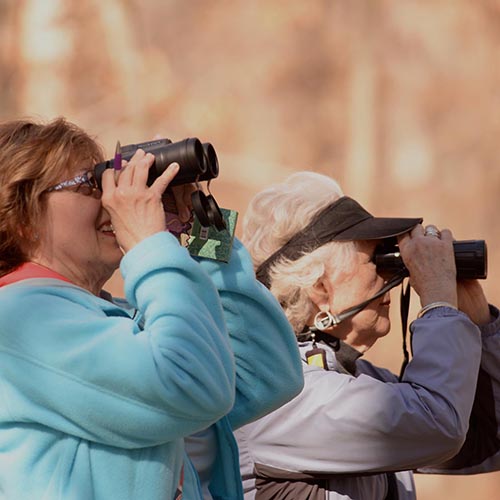
Listen to this Episode:
- From this webpage:
- Find the media player located under the episode picture.
- Click on the green triangle to listen to the audio for this episode.
- From your favorite podcast listening platform:
- Search for “Backyard Ecology.”
Show notes:
The Great Backyard Bird Count is an annual citizen science / community science project hosted by the Cornell Lab of Ornithology, Audubon, and Birds Canada. This international project takes place all over the world for four days every February. In 2021, it will happen February 12-15.
In today’s episode of the Backyard Ecology podcast, we talk with Becca Rodomsky-Bish, Project Leader for the Great Backyard Bird Count, about the project, its importance, and how we can participate. We also talk about some tips and tools for people who may enjoy watching birds, but are just starting to learn how to identify them.
In 2020, approximately 270,000 people from across the world participated in the Great Backyard Bird Count. Approximately 100,000 to 160,000 of those were from North America. One of the cool interactive features on the Great Backyard Bird Count’s website is a map that lights up the locations of new submissions as they are entered. As the weekend progresses, you can see the globe light up with people participating in the project.
Despite its name, the Great Backyard Bird Count isn’t restricted to just your backyard. You can participate anywhere including at home, at a city or county park, at a state park, in the local schoolyard, etc. It’s also possible to do the count from a stationary location, such as a comfy chair by the window, or while walking your favorite trail.
Participants in the Great Backyard Bird Count are asked to identify and count the birds that they see for a minimum of 15 minutes. You can do multiple counts and you can count for longer than 15 minutes if you would like. After making your observations, you enter your data into eBird which is an online database of bird observations from around the world. You can enter your data either on your computer or on your mobile device, depending on your personal preference.
One thing that Becca stressed was that anyone can participate in the Great Backyard Bird Count. You don’t have to be an “expert birder.” If you enjoy watching birds, but aren’t real confident about identify them, that’s ok. We all started somewhere, and we’re all still learning new birds. The good news is that there are lots of tools available to help you. Field guides are one option and is the option that many of us who have been watching and identifying birds for awhile first learned how to use. However, today there are other tools available as well.
One of those tools is an app created by the Cornell Lab of Ornithology. The app is called Merlin and it guides you through the identification process by asking you a series of questions. Based on your answers, it will offer you a few possible identifications for the bird that you are looking at. As of this recording, I haven’t personally used Merlin, but I’ve been told by multiple people that it is pretty good at helping you get to the correct identification.
Even after the Great Backyard Bird Count is over, you can continue to add your bird observations to eBird. The lists created in eBird can be extremely valuable sources of information. As individuals, we can use them to help us keep track of our personal observations overtime and in different locations. At a larger scale, scientists can also use the observations entered into eBird to help answer broader ecological questions.
Even something as simple as knowing what birds are found in a given area can help us understand what the habitat in that area looks like because certain bird species may only be found in certain habitats. Not finding certain birds in an area can also be important information, especially if those birds were once found in that area. That’s one of the ways that long-term databases or lists of birds observed in a single location over a long period of time can be very important in identifying trends or population changes over time.
To date, there have been over 100 scientific papers published using eBird data. The research in many of those papers likely wouldn’t have been possible without the contributions of individuals like you and I to citizen science / community science projects like the Great Backyard Bird Count or eBird. Researchers, like everyone else, can only be in one place at a time. However, if we are all helping to make observations and reporting data, then we can do so much more. Not only does the information we gather make it easier to spot changes occurring right now, but it can also be used in the future to answer questions that we may not even know to ask yet.
Links:
- Great Backyard Bird Count website
- e-Bird
- Merlin
- Other bird identification resources
- Great Backyard Bird Count email: gbbc@birds.cornell.edu
- Backyard Ecology’s website
- My email: shannon@backyardecology.net
Episode image:
- Participants in the Great Backyard Bird Count
- Photo credit: Pamela Monahan

Backyard Ecology: Exploring Nature in Your Backyard
Nature isn’t just “out there.” It’s all around us, including right outside our doors. Hi, my name is Shannon Trimboli, and I am the host of Backyard Ecology. I live in southcentral Kentucky and am a wildlife biologist, educator, author, beekeeper, and owner of a nursery specializing in plants for pollinators and wildlife conservation. I invite you to join me as we ignite our curiosity and natural wonder, explore our yards and communities, and improve our local pollinator and wildlife habitat. Learn more or subscribe to my email list at www.backyardecology.net.

Leave a Reply